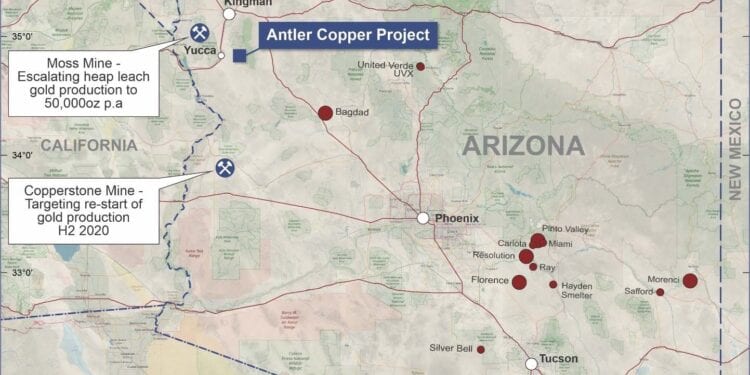New World Resources Limited (ASX: NWC) has begun its inaugural drilling programme at the high-grade Antler Copper Deposit in Arizona.
This initial programme of diamond core drilling is expected to comprise 12 to 16 holes for approximately 2500 metres.
Around 70,000 tonnes of ore was intermittently mined from the Antler Deposit between 1916 and 1970, at a grade around 2.9% Cu, 6.9% Zn, 1.1% Pb, 31 g/t Ag and 0.3 g/t Au. However, subsequent exploration culminated, in 1975, with the definition of a historical resource estimate for the remaining mineralisation comprised of 4.66Mt @ 1.95% Cu, 4.13% Zn, 0.94% Pb and 35.9 g/t Ag.
The company’s immediate objective is to delineate robust JORC‐Code compliant Indicated Resources that can be used in mining studies to evaluate the potential to bring the Antler Deposit back into production in the near‐term.
Managing Director, Michael Haynes, said a major focus of the current drilling programme will be to undertake an appropriate amount of confirmatory drilling within a panel of “high‐confidence, high‐grade mineralisation” immediately below the previous stopes that has previously been drilled and sampled from underground (see Figures 1 and 2). Initial production (if mining operations resume) is expected to be derived from this area. Significant intersections (in unmined mineralisation) in this area included:
9.66m @ 3.57% Cu, 6.63% Zn, 0.82% Pb, 34.4 g/t Ag and 0.34 g/t Au (U30);
7.62m @ 2.80% Cu, 7.29% Zn, 1.61% Pb, 43.4 g/t Ag and 0.54 g/t Au (DDH12);
5.18m @ 2.90% Cu, 12.58% Zn, 2.08% Pb, 63.1 g/t Ag and 0.42 g/t Au (U16);
7.62m @ 2.47% Cu, 3.52% Zn, 2.81% Pb, 64.5 g/t Ag and 0.46 g/t Au (B‐3); and
6.40m @ 1.51% Cu, 10.69% Zn, 1.95% Pb, 52.1 g/t Ag and 0.29 g/t Au, and
5.55m @ 4.39% Cu, 6.34% Zn, 0.53% Pb, 20.6 g/t Ag and 0.56 g/t Au
The company will also undertake in‐fill drilling between the more widely spaced and deeper historical holes that indicate there is a thicker, high‐grade “plunging shoot” down‐dip of the previous stopes.
The company will also:
- Undertake initial shallow drilling adjacent to historical stopes to test the thickness and grade of unmined mineralisation in these areas; and
Conduct initial step‐out drilling outside the “plunging shoot” to test for thicker high‐grade zones of mineralisation.











